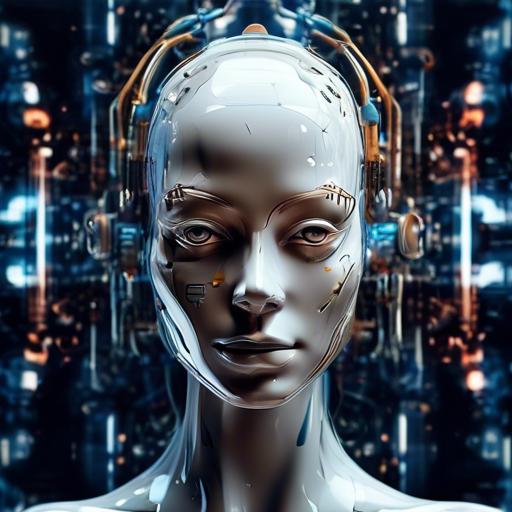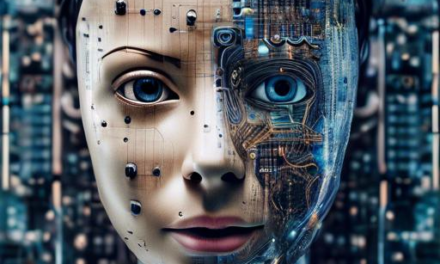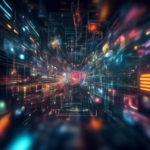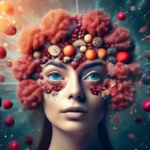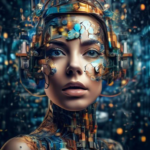Table of Contents
- Reimagining Creativity: AIs Role in Artistic Innovation
- Unleashing New Possibilities: AI Tools in Image Creation
- Blurring Boundaries: How AI Enhances Human Creativity
- AI and Accessibility: Democratizing Artistic Expression
- Ethical Considerations: Navigating AI-Generated Art
- Predicting Trends: The Future Landscape of AI in Imagery
- Practical Applications: Integrating AI into Your Creative Toolbox
- In Retrospect
Reimagining Creativity: AIs Role in Artistic Innovation
Artificial Intelligence (AI) is no longer confined to the realms of science fiction; it has found its way into the vibrant tapestry of artistic expression. From generating breathtaking landscapes to designing intricate patterns, AI’s role in artistic innovation is both groundbreaking and transformative. AI tools like neural networks and generative adversarial networks (GANs) are empowering artists with new possibilities, enabling them to push the boundaries of their creativity **in ways never imagined before**.
AI-driven image creation is **reshaping the canvas** in several remarkable ways:
- Enhanced Efficiency: AI algorithms can quickly analyze large datasets to generate novel images, freeing artists from the constraints of manual processes.
- New Forms of Art: With AI, artists can explore unconventional forms such as data-driven art, fractal patterns, and even collaborative pieces that evolve through machine learning.
- Personalized Art: AI can tailor artworks to individual preferences, creating unique pieces based on user data and engagement metrics.
Moreover, AI is democratizing art creation by making advanced tools accessible to a broader spectrum of creatives. With platforms such as DeepArt and Runway ML, emerging artists can harness complex AI techniques without needing extensive technical knowledge. These platforms provide intuitive interfaces and rich libraries of pre-trained models, making advanced artistic features available at the click of a button.
| AI Tool | Feature | Usage |
|---|---|---|
| DeepArt | Style Transfer | Transforms photos into artworks using famous painting styles. |
| Runway ML | Generative Models | Provides pre-trained models for image generation. |
| Artbreeder | Collaborative Art | Allows users to blend images together to create new artworks. |
In a world where boundaries between human and machine creativity are increasingly blurred, AI stands as a potent collaborator rather than a replacement. Artists leveraging these advanced tools are discovering unique artistic expressions while stimulating audiences with imagery that was previously inconceivable. The intersection of AI and art promises a future where creativity flows unbounded, and the possibilities are limited only by our imagination.
Unleashing New Possibilities: AI Tools in Image Creation
Imagine a world where your wildest artistic visions come to life with just a few clicks. This is not science fiction anymore, but a vibrant reality thanks to a new generation of AI-powered image creation tools. These groundbreaking technologies are transforming how artists, designers, and content creators approach their craft, opening doors to creativity that were previously unimaginable.
The beauty of AI in image creation lies in its ability to handle complex tasks with ease and precision. With tools like deep learning algorithms, creative professionals can now generate high-quality images from simple sketches, automate the process of photo editing, and even invent entirely new visual styles. The **efficiency** and **flexibility** provided by these tools save countless hours of manual labor and enable artists to focus more on their creative expression.
Moreover, AI democratizes the creative process. No longer are advanced artistic skills a prerequisite for producing stunning visuals. **AI tools** such as DALL-E and Artbreeder allow anyone—from novice to professional—to create mesmerizing artwork. With just a few descriptive keywords, these platforms can generate diverse and complex images, empowering everyone to become an artist.
Let’s explore some key features that these AI tools offer:
- Image Synthesis: Generate unique images from text descriptions.
- Style Transfer: Apply the style of one image to another seamlessly.
- Auto-Colorization: Transform black-and-white photos into vibrant, colorized versions.
- Photo Restoration: Revive old and damaged images with remarkable clarity.
| AI Tool | Main Feature |
|---|---|
| DALL-E | Text-to-image synthesis |
| Artbreeder | Collaborative image remixing |
| Prisma | Artistic photo effects |
The potential of AI to revolutionize image creation is immense. As these technologies continue to evolve, they will undoubtedly bring forth new and exciting possibilities, making the future of art and design more innovative, inclusive, and accessible than ever before.
Blurring Boundaries: How AI Enhances Human Creativity
Artificial Intelligence is not just a buzzword. It’s a transformative tool that’s revolutionizing the way artists and creators approach image creation. With AI, the **boundaries between human creativity and machine intelligence are becoming increasingly blurred**, opening up new horizons for visual art and design. This amalgamation of human ingenuity and machine-learning capabilities presents a plethora of exciting opportunities.
One of the primary ways AI enhances creative processes is through **generative adversarial networks (GANs)**. By training on vast datasets of images, GANs can generate unique, high-quality visuals that can either serve as inspiration or the foundation for new artworks. Artists can manipulate these AI-generated images, integrating elements into their work in ways that were previously unimaginable.
- Texture Creation: AI can generate intricate textures that would take a human hours, even days to create.
- Style Transfer: Artists can borrow styles from famous paintings and apply them to their work.
- Object Detection: AI can identify and extract objects from photos, which can then be repurposed in new designs.
The collaboration between humans and AI doesn’t come without its own set of tools. Many platforms now integrate AI to simplify complex tasks:
| Platform | AI Feature |
|---|---|
| Adobe Creative Cloud | AI-powered color matching |
| DeepArt.io | Style transfer |
| RunwayML | Real-time video editing using AI |
Moreover, AI tools are becoming more intuitive and accessible. Applications such as RunwayML allow creators to experiment with AI models without needing extensive coding knowledge. This democratization of technology **empowers more artists to explore the potential of AI**, fostering a diverse range of creative outputs and pushing the standards of visual arts ever higher.
AI and Accessibility: Democratizing Artistic Expression
In a world increasingly driven by visuals, the barriers to entry into artistic expression have often been formidable. Traditional means of creating visually appealing content can be limited by access to materials, technical skill, or physical ability. However, AI is dramatically shifting the landscape, offering new possibilities that democratize artistic expression. With advanced algorithms and intuitive interfaces, AI-powered tools are making art more accessible to everyone.
Imagine being able to transform your vision into reality with just a few clicks or voice commands. AI-powered software enables users to create detailed images, digital paintings, and even elaborate animations without requiring any formal training in art or design. This is particularly empowering for individuals with disabilities, who can now channel their creativity through adaptive technologies that cater to their specific needs. The implications are profound, as these tools not only foster self-expression but also promote inclusivity by breaking down traditional barriers.
Key AI features enhancing accessibility include:
- Voice Command Integration: Allows users to guide the creative process verbally, making it accessible to those with mobility challenges.
- Text-to-Image Generation: Users can describe their envisioned artwork in words, and the AI translates it into a visually compelling image.
- Intelligent Templates: Provides pre-designed elements that users can easily combine and customize, simplifying complex design tasks.
Below is a snapshot of how AI tools compare with traditional methods:
| Aspect | Traditional Methods | AI-Powered Tools |
|---|---|---|
| Skill Requirement | High | Low to None |
| Accessibility | Limited | Universal |
| Time Investment | Long | Short |
Furthermore, these AI tools are bringing together diverse communities of creators who might not have considered themselves artists in traditional terms. For instance, students, hobbyists, and professionals from various fields are leveraging these technologies to express ideas visually, collaborate on projects, and even pursue careers in digital art. The ripple effect of such democratization cannot be overstated; as more people gain access to these tools, the pool of unique, creative voices continues to grow.
Interestingly, the evolution of AI in the realm of artistic expression is just beginning. With advancements in machine learning and neural networks, the future holds even more promise. Enhanced capabilities like real-time collaboration, contextual understanding, and augmented creativity support are on the horizon. It’s an exciting era where anyone, regardless of background or ability, can partake in the joy of creating beautiful and meaningful art.
Ethical Considerations: Navigating AI-Generated Art
- Need for transparency in how AI-generated art is labeled and presented.
- Importance of creating guidelines that outline acceptable use of AI in art creation.
- Developing systems for artists to opt-in or opt-out of having their work used by AI programs.
| Aspect | Ethical Impact |
|---|---|
| Originality | Challenges traditional notions of creativity |
| Intellectual Property | Risks of copyright infringement |
| Bias | Potential for perpetuating stereotypes |
Predicting Trends: The Future Landscape of AI in Imagery
The realm of artificial intelligence-driven imagery is evolving at a breakneck pace, redefining the boundaries of creativity and technical prowess. As we peer into the future, several anticipated trends are poised to shape the landscape:
- Hyper-Realistic Image Synthesis: Artists and developers will harness AI to create images so lifelike that they are indistinguishable from actual photographs. The implications for entertainment, marketing, and even social media are tremendous, as authenticity becomes both a creative tool and a challenge.
- Dynamic Storytelling: Through AI, static images will transform into dynamic narratives. Imagine interactive artworks that change based on user interactions or data-driven visuals that adapt to real-time events.
- Accessibility & Inclusion: AI advancements will democratize image creation, enabling individuals with varying skill levels to produce compelling graphics. Tools powered by artificial intelligence will provide templates, suggestions, and corrections, making high-quality imagery accessible to all.
In the future, the convergence of AI with augmented and virtual reality will redefine immersive experiences. Artists will be able to craft multisensory environments where viewers can “step into” artworks, interacting with elements that respond intelligently to their presence. This fusion of technology will blur the lines between the real and the virtual, opening new avenues for experiential design.
Additionally, predictive analytics will play a key role in content creation. By analyzing trends and user preferences, AI systems can forecast popular visual styles and themes, guiding creators to produce content that resonates with audiences. This intelligence will enable brands and artists to stay ahead of the curve, tailoring their output to zeitgeist shifts and emerging interests.
| Trend | Impact |
|---|---|
| Hyper-Realistic Image Synthesis | Enhanced realism in media and marketing |
| Dynamic Storytelling | Interactive and adaptive visual narratives |
| Accessibility & Inclusion | Creative empowerment for all skill levels |
| Immersive AR/VR Experiences | New dimensions in experiential design |
| Predictive Analytics | Future-proofed content strategy |
Practical Applications: Integrating AI into Your Creative Toolbox
Incorporating AI into the creative process can greatly enhance productivity and open up new avenues of artistic expression. Whether you’re a seasoned professional or just starting out, these tools can seamlessly integrate into your existing workflow, amplifying your creativity and simplifying the technical aspects of image creation.
- Automated Image Enhancements: AI-powered software can automatically adjust lighting, color balance, and sharpness to improve overall image quality.
- Creative Filter Applications: Use AI to apply complex filters that mimic various artistic styles and techniques, from impressionism to modern digital art.
- Content Generation: AI can generate entire visual elements or backgrounds, which you can further customize to suit your artistic vision.
Imagine being able to use AI to draft initial design concepts for a client project. With the push of a button, you can generate multiple variations of a concept, offering a range of options without the exhaustive time commitment. This is particularly beneficial for tasks like A/B testing different visual styles.
| AI Tool | Function | Usage Example |
|---|---|---|
| Adobe Sensei | Enhancement & Adjustments | Automatic color correction |
| NVIDIA GauGAN | Content Generation | Creating realistic landscape designs |
| Runway ML | Style Transfer | Turning photos into paintings |
Moreover, AI can assist in mundane yet critical tasks such as organizing and tagging your image library, allowing you to focus more on the creative process itself. Advanced algorithms analyze metadata and visual elements to categorize images, streamlining your workflow and making it easier to locate specific files when you need them.


